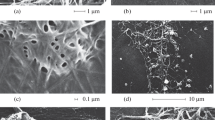Abstract
Implants of bone matrix, capable of inducing new bone formation, were prepared by decalcifying cortical bone in 0.6 N HCl at 2°C for 48 hours. The inductive property could be inactivated by decalcification in 0.6N HCl containing 66.5% ethanol. When implanted into muscle, both the active and inactive implants were invaded by mesenchymal cells. There was no significant difference in the DNA content of active and inactive implants, but only the active implants induced the synthesis of alkaline phosphatase by a new cell population. Alkaline phosphatase activity was present at 5 days, reached a peak at 20 days after implantation, then declined to 15% of the maximum value by the 40th day after implantation. The deposition of calcium in the implants, coinciding with the differentiation of new bone, began about 12 days after implantation, and gradually increased throughout the 40-day experimental period. Neither recalcification of old matrix nor differentiation of bone occurred in the acid-alcohol-inactivated implants. Induction of alkaline phosphatase synthesis occurred in the pre-osseous phase of morphogenesis 5 days before the appearance of calcium deposits and was not directly correlated with the mechanism of calcification.
Résumé
Des implants de matrice osseuse, susceptible d'engendrer une néoformation osseuse, sont préparés en décalcifiant de l'os cortical dans 0,6 N HCl à 2° pendant 48 heures. Les propriétés d'induction ont pu être inactivées en décalcifiant dans 0,6 N HCl contenant 66,5% d'alcool ethylique. Après implantation musculaire, les implants actifs et inactifs sont envahis par des cellules mésenchymateuses Il n'existe pas de différence significative dans le contenu en DNA d'implants actifs et inactifs, cependant seuls les implants actifs induisent la synthèse de phosphatase alcaline par des cellules nouvellement formées. L'activité en phosphatase alcaline s'observe à 5 jours; elle atteint un pic à 20 jours, après implantation, et décroit à 15% de la valeur maximale au 40ème jour suivant l'implantation. Le dépôt de calcium dans les implants, contemporain de la formation d'os nouveau, débute environ 12 jours après l'implantation et diminue progressivement pendant les 40 jours de la période expérimentale. Ni recalcification de la matrice originale, ni néoformation d'os ne s'observent dans les implants inactivés par l'acide et l'alcool. L'induction de synthèse de phosphatase alcaline s'observe, dans la phase pré-osseuse de morphogène, 5 jours avant le dépôt de calcium et n'est pas directement en rapport avec le mécanisme de la calcification.
Zusammenfassung
Zur Gewinnung von Knochenmatrix-Implantaten, welche neue Knochenbildung anregen können, wurde kortikaler Knochen während 48 Std bei 2° mit 0,6 N HCl entkalkt. Die Fähigkeit neuen Knochen zu bilden, konnte zerstört werden, wenn der zur Entkalkung verwendeten 0,6 N HCl 66,5% Äthylalkohol zugesetzt wurde. Im Muskel implantiert wurden sowohl die aktiven als auch die inaktiven Implantate von mesenschymalen Zellen überschwemmt. Es fand sich kein signifikanter Unterschied des DNS-Gehaltes zwischen aktiven und inaktiven Implantaten, jedoch wurde die Synthese von alkalischer Phosphatase durch eine neue Zellpopulation nur im aktiven Implantat hervorgerufen. Die Aktivität der alkalischen Phosphatase lag nach 5 Tagen vor, erreichte 20 Tage nach Implantation den Höhepunkt, um nach dem 40. Tag nach Implantation auf 15% des Maximalwertes abzusinken. Die Calciumablagerung in den Implantaten, welche mit der Differenzierung von neuem Knochen zusammenfällt, begann ungefähr 12 Tage nach der Implantation und nahm während der 40tägigen Experimentierphase stetig zu. Im mit Säure-Alkohol inaktivierten Implantat fand weder eine Mineralisation der alten Matrix, noch eine Differenzierung von Knochen statt. Die Synthese von alkalischer Phosphatase wird im Verlaufe der Morphogenesis in der Phase vor der Knochenbildung angeregt, d. h. 5 Tage vor dem Auftreten von Calciumablagerungen. Sie steht nicht in direktem Zusammenhang mit dem Mineralisationsmechanismus.
Similar content being viewed by others
References
Ceriotti, G.: A microchemical determination of desoxyribonucleic acid. J. biol. Chem.198, 297–303 (1952).
Firschein, H. E.: Collagen and mineral dynamics in bone. Clin. Orthop. Rel. Res.66, 212–225 (1969).
—, Shill, J. P.: The determination of total hydroxyproline in urine and bone extracts. Analyt. Biochem.14, 296–304 (1966).
Frankel, S., Reitman, S. (eds.): Clinical laboratory methods and diagnosis, 6th ed. p. 118. St. Louis: C. V. Mosby 1963.
Huggins, C. B.: Epithelial osteogenesis—a biological chain reaction. Proc. Amer. Phil. Soc.113, 458 (1969).
Schneider, W. C.: Determination of nucleic acids in tissues by pentose analysis. In: Methods in enzymology, vol. III (S. P. Colowick and N. O. Kaplan, eds.), p. 680. New York: Academic Press 1957.
Strates, B. S., Urist, M. R.: Origin of the inductive signal in implants of normal and lathyritic bone matrix. Clin. Orthop. Rel. Res.66, 226–240 (1969).
Urist, M. R., Dowell, T. A., Hay, P. H., Strates, B. S.: Inductive substrates for bone formation. Clin. Orthop. Rel. Res.59, 59–96 (1968).
—, Hay, P. H., Dubuc, F., Buring, K.: Osteogenetic competence. Clin. Orthop. Rel. Res.64, 194–220 (1969).
—, Siiverman, B. F., Buring, K., Dubuc, F. L., Rosenberg, J. M.: The bone induction principle. Clin. Orthop. Rel. Res.53, 243–283 (1967).
Willis, J. B.: Determination of metals in blood serum by atomic absorption spectroscopy. I. Calcium. Spectrochim. Acta16, 259–272 (1960).
Author information
Authors and Affiliations
Additional information
This investigation was supported in part by research grant DE-02103 from the National Institute of Dental Research and in part by a grant from the John A. Hartford Foundation.
Rights and permissions
About this article
Cite this article
Firschein, H.E., Urist, M.R. The induction of alkaline phosphatase by extraskeletal implants of bone matrix. Calc. Tis Res. 7, 108–113 (1971). https://doi.org/10.1007/BF02062599
Received:
Accepted:
Issue Date:
DOI: https://doi.org/10.1007/BF02062599




